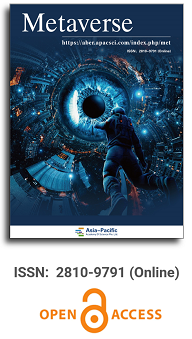
Asia Pacific Academy of Science Pte. Ltd. (APACSCI) specializes in international journal publishing. APACSCI adopts the open access publishing model and provides an important communication bridge for academic groups whose interest fields include engineering, technology, medicine, computer, mathematics, agriculture and forestry, and environment.



Analysis of the diverse advantages and paths of traditional culture dissemination in online games
Vol 5, Issue 2, 2024
Download PDF
Abstract
With the development of the new media era, factors such as digitization and entertainment are driving changes in the way traditional culture is disseminated. In comparison to traditional distribution media, online games are more vivid, capable of retaining the characteristics of traditional culture while undergoing a livelier transformation and development, and are disseminated in a manner that is widely appealing to the masses. This study, based on the new media characteristics of online games and combined with the current situation of traditional culture dissemination in China and domestic game cases, analyzes the diverse advantages of online games in cultural dissemination, including form, content, promotional methods, and cross-border linkage. It summarizes a dissemination path system starting from three points: cultural resources, game content, and game audience, in order to contribute to the enhancement of the dissemination value of online games and the promotion of contemporary dissemination of traditional culture.
Keywords
References
- Yu GM, Geng XM. Metaverse: Future Ecological Landscape of Mediated Society. Journal of Xinjiang Normal University. 2022; 43(3): 110–118.
- Anderson EF, McLoughlin L, Liarokapis F, et al. Developing serious games for cultural heritage: a state-of-the-art review. Virtual Reality. 2010; 14(4): 255–275. doi: 10.1007/s10055-010-0177-3
- Wu XL. Network, Game, and Online Game. Contemporary Communication. 2006; 1: 54–58.
- Luo B. On the Inheritance of Chinese Traditional Culture by Domestic Online Games. Southeast Communication. 2007; 8: 102–103.
- Ren JD. The Communication of Online Games and Traditional Culture. Ethical Research. 2010; 6: 111–113.
- Chen QH. Expression Innovation of Chinese Traditional Culture from the Perspective of the Game Industry. Publishing Horizons. 2021; 6: 85–87.
- Hu Y, Zhu GQ. Contemporary Communication of Online Games and Excellent Traditional Chinese Culture. Nanjing Social Sciences. 2022; 7: 155–162.
- Gabe Z. The Gamification Revolution: Driving the Future Business Models. China Renmin University Press; 2014.
- Li BY, Bai Y. Technical Features and Morphological Evolution of Artificial Intelligence Generated Content (AIGC). Document, information & Knowledge. 2023; 40(1): 66–74.
- The 52nd China Internet Development Status Report Released. Available online: https://cnnic.cn/n4/2023/0828/c199-10830.html (accessed on 12 May 2024).
- China Game Industry Report 2018-2023. Available online: http://www.cadpa.org.cn/index.html (accessed on 12 May 2024).
- Wu LL. Construction of Communication Model and Analysis of Communacation Mechanism of Online Games: Based on Large-scale Role-playing Online Games. Fujian Forum (Humanities and Social Sciences Edition). 2010; 4: 104–105.
- Cui BF. Visual Communication of Excellent Traditional Chinese Culture in the Metaverse Space. Media. 2024; 4: 71–74.
- Zeiler X, Thomas S. The relevance of researching video games and cultural heritage. International Journal of Heritage Studies. 2020; 27(3): 265–267. doi: 10.1080/13527258.2020.1762705
- Camuñas-García D, Cáceres-Reche MP, Cambil-Hernández M de la E, et al. Digital Game-Based Heritage Education: Analyzing the Potential of Heritage-Based Video Games. Education Sciences. 2024; 14(4): 396. doi: 10.3390/educsci14040396
- Zhang S, Chen XJ. Real Problems and Innovative Experiences of Chinese Culture Communication of Domestic Games. Young Journalist. 2022; 24: 72–77.
- Hanes L, Stone R. A model of heritage content to support the design and analysis of video games for history education. Journal of Computers in Education. 2018; 6(4): 587–612. doi: 10.1007/s40692-018-0120-2
- Kevin W. Gamification: The Power of New Forces Changing Future Business. Zhejiang People’s Publishing House; 2014.
- Boom KHJ, Ariese CE, van den Hout B, et al. Teaching through Play: Using Video Games as a Platform to Teach about the Past. In: Communicating the Past in the Digital Age: Proceedings of the International Conference on Digital Methods in Teaching and Learning in Archaeology (12th-13th October 2018). Ubiquity Press; 2020. pp. 27–44. doi: 10.5334/bch.c
- Dobre GC, Gillies M, Pan X. Immersive machine learning for social attitude detection in virtual reality narrative games. Virtual Reality. 2022; 26(4): 1519–1538. doi: 10.1007/s10055-022-00644-4
Supporting Agencies
Copyright (c) 2024 Martin Pazmino, Yihan Huang, Baoping Yan
License URL: https://creativecommons.org/licenses/by/4.0/

This site is licensed under a Creative Commons Attribution 4.0 International License (CC BY 4.0).

Prof. Zhigeng Pan
Professor, Hangzhou International Innovation Institute (H3I), Beihang University, China

Prof. Jianrong Tan
Academician, Chinese Academy of Engineering, China
Conference Time
December 15-18, 2025
Conference Venue
Hong Kong Convention and Exhibition Center (HKCEC)
...
Metaverse Scientist Forum No.3 was successfully held on April 22, 2025, from 19:00 to 20:30 (Beijing Time)...
We received the Scopus notification on April 19th, confirming that the journal has been successfully indexed by Scopus...
We are pleased to announce that we have updated the requirements for manuscript figures in the submission guidelines. Manuscripts submitted after April 15, 2025 are required to strictly adhere to the change. These updates are aimed at ensuring the highest quality of visual content in our publications and enhancing the overall readability and impact of your research. For more details, please find it in sumissions...






.jpg)
.jpg)

